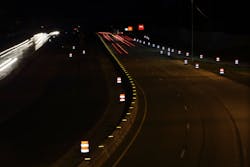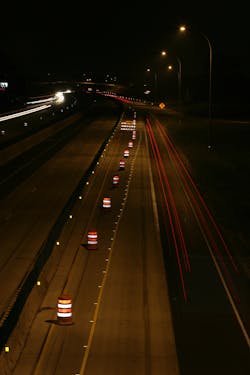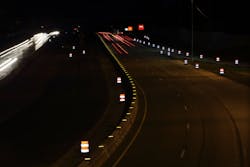Ready, steady and go
The Michigan DOT is currently rebuilding and modernizing 18 miles of I-75 and is working with 3M to integrate cutting-edge product concepts designed to support automated and connected vehicles via updated infrastructure.
The Michigan Department of Transportation (MDOT) is currently rebuilding and modernizing I-75, which not only includes updating interstate geometrics, connections, safety and travel-time reliability, but also the capacity to safely move traffic at the 70-mph posted speed limit.
The state began updating the interstate in 2016 and will complete the first 18-mile modernization in September of this year. The full project includes a decade-long series of updates that will take place in eight phases. Undoubtedly, the project also will serve as a guide for state transportation departments nationwide, as they evaluate how to update highway infrastructure to best serve the needs of increasingly automated vehicles.
MDOT is working with 3M to integrate cutting-edge product concepts designed to support automated and connected vehicles via updated infrastructure. The department will then study how autonomous vehicles respond to the new materials and use it as a pilot for future updates statewide.
Why I-75?
I-75 was originally built in the 1960s. At that time, the area through which it runs was primarily farmland, and thus the interstate had minimal traffic. Today, I-75 carries more than 170,000 vehicles per day and covers 396 miles of southern Michigan farmland, northern forests, suburban communities and the urban core of Detroit. It also cuts through Automation Alley where most automotive research and development in the U.S. is now consolidated.
Given that the “Detroit 3”—and now Asian and European automakers—all have a presence near I-75, along with the largest number of automobile research and development centers in the country, MDOT felt this corridor would be an ideal location for manufacturers to start evaluating and field-testing infrastructure designed specifically for automated and connected vehicles. In fact, there are more than 23,000 businesses three miles to the east and west of I-75, many of which serve the automotive industry for research, development or supply.
“The I-75 project is designed to transform a driving experience into an opportunity to evaluate new technologies,” said Michele Mueller, senior project manager for MDOT’s Connected and Automated Vehicle Program. “Installing the next-generation infrastructure along the I-75 corridor allows for advanced testing and gives OEMs and suppliers the ability to understand how the infrastructure fits into next-generation auto development.”
Leading the charge to evaluate next-generation infrastructure designed to improve automated vehicle guidance, the Michigan DOT is incorporating pioneering 3M signage concepts, pavement markings and work-zone barrels into I-75, many of which include invisible codes that can be “seen” by the sensor-equipped car, but not the driver.
Building “smarter” roads
Improvements to I-75 include the strategic elimination of high-crash locations and the incorporation of machine-readable infrastructure that supports automated and connected vehicles.
For more than 78 years, 3M has been improving road safety and mobility, working to bring families home safely and ultimately deliver on the goal of zero deaths in highway transportation. In other words, the company already has some skin in the safety game, making MDOT’s choice to partner up a win-win. The levels of vehicle automation continue to rapidly advance. With this in mind, 3M is designing infrastructure, such as road signs, work-zone warnings and pavement markings, that will meet the needs of those vehicles as well as preserve the roadways for safe navigation by non-automated vehicles. For example, next-generation pavement markings will provide increased readability for cameras in automated vehicles as well as better visibility for human drivers.
Automated cars depend on cameras, radar, ultrasonic sensors and laser-mapping tools to determine where they are, both on the road and in relation to their surroundings. These sensors may be used alone or in concert with GPS to keep the car on the road and within the lines. Current sensors in vehicles that have assisted driving capabilities perform best when lane markings are bright and have a high contrast to the road background. Industry executives working to develop automated vehicles say outdated and shoddy road infrastructure is a challenge in the development of self-driving cars. Poor pavement markings and signage on the 3 million miles of paved roads in the U.S. are forcing automakers to develop more sophisticated systems to ensure performance and safety.
Leading the charge to evaluate next-generation infrastructure designed to improve automated vehicle guidance, MDOT is currently incorporating pioneering 3M signage concepts, pavement markings and work-zone barrels into I-75. Although human drivers on I-75 may notice few changes in the traffic signs, many of the signs now include invisible codes that can be “seen” by the sensor-equipped car, but not the driver. The codes are embedded in the signs and allow for direct communication between the infrastructure and the vehicle.
An embedded code confirms the visible message on the sign, providing redundant guidance to the vehicle, confirming the environment and the information on the sign. For example, a “Road Work Ahead” sign with an embedded code communicates the message to the driver and vehicle in two independent ways—visually as an orange diamond, and also via the embedded code accessible only to the sensor on the vehicle. Together, the two methods increase safety as they independently communicate and verify the message on the sign.
“3M product solutions are evolving right along with the industry,” said Colin Sultan, Connected Roads business manager for 3M. “The main benefit of this partnership with MDOT is that together we can create a situation where tier-one suppliers and OEMs can test new infrastructure technologies right along with the improvements they are making on the vehicles.”
In addition to providing assisted and automated vehicles with redundant systems to help ensure communication of critical data, 3M road-sign solutions also may be used to communicate information dynamically. For example, the embedded codes and wireless communication can convey real-time, updated information to vehicles regarding current or future road and weather conditions.
“Let’s say it’s sleeting and there is a curve a mile up the road. Based on weather data and data from other cars, the safe speed for the car to navigate the curve may be slower than the advised speed,” said Kris Hansen, Connected Roads lab manager at 3M. “A connected sign with embedded code could communicate all this information to the vehicle, so the situational awareness is high and the car can respond accordingly. We can warn these vehicles well in advance through up-to-date messages.”
The Michigan DOT hopes updates to the Automation Alley corridor of I-75 will help steer the conversation about automated and connected vehicles to the forefront, alerting the public—and DOTs nationwide—to the fact that “this reality is coming to their lives.”
A road to the future
MDOT has been investigating ways to update the state’s infrastructure to accommodate automated and connected vehicles for over a decade. State transportation officials see the updates currently being rolled out on I-75 as a natural progression of MDOT’s intelligent transportation system (ITS), which allows the state to communicate real-time information and updates to drivers, commercial traffic and law enforcement. MDOT’s vision centers around advancing the current ITS system to a system that further supports the automated technology being advanced today. “Essentially, we had a very strong ITS backbone system that really laid the groundwork for us to be able to adapt the existing system to new technologies,” said Mueller.
In addition to preparing for autonomous cars, the state also is planning ahead for the eventuality of self-driving commercial trucks, which are already being developed. Given that Michigan currently has four Canadian border crossings and is building a fifth, there is a high volume of commercial truck traffic through the state.
MDOT also is working with local military officials on how to accommodate self-driving military vehicles, and is planning for how to handle infrastructure for the agriculture industry, the second-largest industry in Michigan.
Not only have 3M and MDOT partnered to test the innovative infrastructure solutions to I-75, but both 3M and MDOT are actively collaborating with multiple automakers and camera manufacturers to deliver on the full potential of this real-world laboratory.
This collaboration allows 3M to work with the sensor companies and the automakers to make sure the vehicles and the infrastructure are able to communicate with each other, and that both elements of the vehicle-to-infrastructure interaction are delivering as needed.
“The innovations in infrastructure designed to accommodate autonomous vehicles are exciting and future-forward. Equally as exciting is the collaboration demonstrated to deliver on the potential for the I-75 update,” said Hansen.
Ultimately, for any infrastructure-related improvements, multiple municipalities, cities, states and federal transportation departments will need to work together to ensure infrastructure across the nation is consistent, standardized and “machine-readable.”
“Developing standards will be pivotal to the advancement and acceptance of this technology,” Mueller said. “When I’m traveling in an automated vehicle in the future and I need to cross a state border, I need to know there will be a seamless transition without interruption to the services provided by the vehicle and infrastructure. This type of transition needs to occur on all roads, no matter who the owner and operator is. DOTs need to be thinking of how they will accommodate the needs of the future—and there is a challenge in this space, because it seems the technology is changing rapidly.”
MDOT hopes updates to the Automation Alley corridor of I-75 will help steer the conversation about automated and connected vehicles to the forefront, alerting the public—and DOTs nationwide—to the fact that “this reality is coming to their lives.”
“We would encourage every state to get actively involved and think about how automated driving will impact their future infrastructure,” said Mueller.
--------------
Peterson is a Connected Roads project manager at 3M.


